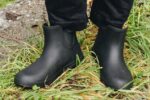Apart from the usual lacing method of tying boots, there are several other ways of tying logger boots. However, it depends upon how you want to lace your logger boots.
Although the complicated methods of tying a boot might take more time and effort to do it correctly, they are more comfortable, give your logger boots a stylish look, fits better, and provides more security to your feet.

You can tie logger boots by using the heel-lock lacing method, the 2-1-3 lacing method, the ladder lacing method, and the army lacing method. Let’s deep dive into each one…
The Heel-Lock Lacing Method
This method of tying logger boots is best for those people who would have to walk through rugged terrains. Mostly hikers and mountaineers prefer tying their boots using this method. It is known as the heel-lock method because it provides a tighter grip on your heels.
How to tie your boots using The Heel-Lock Lacing Method?
a) Firstly, lace up your boots normally in a criss-cross fashion. Start from the bottom and string the laces through each of the bottom eyelets.
b) Next, run each lace-up vertically so that each lace goes straight up from one eyelet to the one above it.
c) Now, you will have to tie each lace through the opposite lace. Keep doing this until you reach the top eyelet.
d) Finally, pull the laces tight and tie the standard bow knot.
Advantages of The Heel-Lock Lacing Method
1.) Provides more ankle support
2.) This lacing method is more secure and keeps your heels tighter. As there won’t be much movement in the boot, your feet will remain safe while walking on rough terrain.
3.) The heel-lock lacing method is very easy as you only have to work with the top two hooks or eyelets.
Disadvantages of The Heel-Lock Lacing Method
Tying logger boots using the heel-lock method takes more time than the standard lacing methods.
The 2-1-3 Lacing Method
Another method of tying logger boots is the 2-1-3 lacing method. People who don’t like to tie their boots too tightly and want to avoid the issue of “lace bite”, prefer lacing their boots using the 2-1-3 method.
How to tie your boots using the 2-1-3 Method?
You need to identify the 3 pairs of eyelets around the ankle. Now, start lacing your boots normally until you get to the bottom one (Do not tie the lace through each eyelet in order).
The lace should go across the first of the three eyelets, then back across to the first, and finally across to the top (third one) eyelet in the ankle area (This is why it is known as the 2-1-3 lacing method).
Finally, tie normally up to the top of the boot.
Advantages of the 2-1-3 Lacing Method
Your feet will not only remain comfortable but also secure.
The uncomfortable pinching that occurs when your boots are laced too tightly won’t happen if you tie your boots using this method.
Disadvantages of the 2-1-3 Lacing method
Tying boots using the 2-1-3 method can be a bit complicated for beginners.
The Ladder Lacing Method
The ladder-lacing method is the most time-consuming method of tying logger boots but also provides the best support to your feet. This method is mostly used by members of the military, as once you tie your boots using this method, you neither have to worry about your boots getting untied nor about lack of support. The ladder lacing method is also preferred by hikers, mountaineers, and paratroopers who mostly spend a long time on their feet.
How to tie your boots using The Ladder Lacing method?
1.) Start from the bottom eyelet and tie the lace from inside to outside.
2.) Next, the lace will go straight up vertically from outside to inside. Tie the laces below the vertical lines until you go to the opposite side. This will create an interlocking pattern that will keep your logger boot laces tight.
3.) Now, you need to pull the lace-up and put it across the next eyelet up from the lace to the bottom vertically. Do this repeatedly until you reach the top.
4.) Finally, finish tying your boot with your regular knot.
Advantages of The Ladder Lacing method
Once you tie the laces of your boots using the ladder method, they will hold on their own and will give you utmost support.
If you intend to spend a lot of time moving on your feet, then this method will prove more beneficial to you.
Disadvantages of The Ladder Lacing Method
This method is a bit complicated and time-consuming.
It will be hard to tighten your boots properly once they are fully laced.
The Army Lacing Method
This method is mostly used by army personnel. These boots are made up of thick, tough leather, and does not flex easily.
How to tie your boots using The Army Lacing Method?
1.) Initially, start from the bottom and then tie the laces from inside to outside.
2.) Next, tie the laces upwards through the next eyelets without crossing them.
3.) Now, tie the laces through the eyelets on the opposite side and go vertically from the remaining eyelets.
4.) Continue doing this and tie your boots normally. If you use this method correctly, all the verticals will remain outside, and the crossovers will remain inside.
Advantages of The Army Lacing Method
This method reduces the crossovers that will not only hold down the sides of the boot but will also allow the leather to crease explicitly.
Disadvantages of The Army Lacing Method
This method is time-consuming and does not offer much ankle support or security.
Check the video below and discover the right logger boots for you
Conclusion
Each of these methods stated above for tying the logger boots is different. However, it is recommended that you should choose the one that makes you feel comfortable and provides better ankle support.







